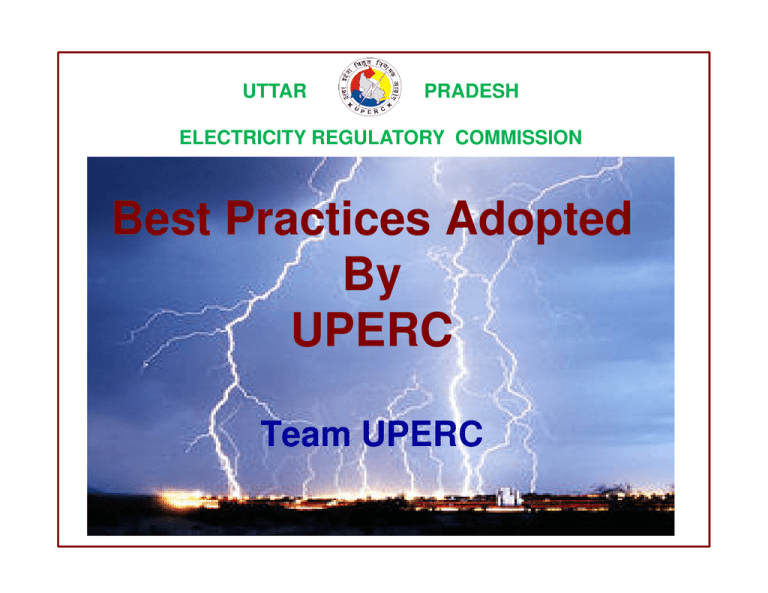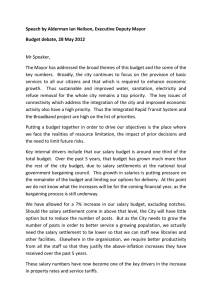Best Practices Adopted By UPERC Team UPERC
advertisement

UTTAR PRADESH ELECTRICITY REGULATORY COMMISSION Best Practices Adopted By UPERC Team UPERC FIRST STEPS TOWARDS REFORMS • Central Government set in motion the current reform process in the Power Sector by notifying The Electricity Regulatory Commissions Act 1998. • U.P. Electricity Regulatory Commission was thus created on 10th September 1998 under the Electricity Regulatory Commissions Act 1998. • Government of U.P. subsequently enacted the U. P. Electricity Reforms Act - 1999 which came in force on 14.1.2000. • UPERC was declared as the Commission under the Reforms Act 1999. Developments Post EA 2003 UPERC has issued following main regulations under the EA 2003 for regulation of Power Industry within the State : i) UPERC ‘Conduct of Business’ Regulation 2004 specifying the manner and procedures in which Commission conducts its business. ii) UPERC Service Regulation 2004, which lays downs the service conditions for its employees and staff. iii) UPERC Fee and Fine Regulation which specifies the fees payable by a petitioner for the different functions i.e. grant of licence, determination of Tariff etc. and fines that can be imposed. Developments Post EA 2003 (continued) • UPERC ‘Terms and Conditions of Distribution Licence’ Regulations & UPERC ‘Terms and Conditions of Transmission Licence’ Regulations. These regulations specify the conditions for grant of Distribution and Transmission Licence as well as service obligations of the Transmission and Distribution Licensees. • UPERC ‘Consumer Grievance Redressal Forum and Electricity Ombudsman’ Regulation 2007. These specify the structure of Consumer Grievance Redressal Forum and Electricity Ombudsman office as well as the procedure for filing an application before the Forum or appeal before the Electricty Ombudsman. Developments Post EA 2003 (continued) • UPERC ‘Electricity Supply Code’ which lays down various rules, procedures and performance standards related to Distribution Business. • UPERC ‘Intra-State Trading of Electricity’ Regulation which specifies all technical & commercial conditions for grant of Trading License and also specifies the duties and functions of the Electricity Trader. • UPERC has issued policy guidelines for generation of power through captive power houses and cogenerators. Developments Post EA 2003 (continued) • UPERC ‘Terms & Condition for Determination of Generation Tariff’ Regulation which specify the principles of Tariff Determination. All costs are classified as controllable or uncontrollable. Performance parameter are benchmarked over multi year timeframe for the recovery of full costs. • UPERC ‘Open Access’ Regulations and ‘ Intra state Transmission Connectivity Regulations’ and procedures. These regulations specify the criteria for grant of open access and charges to be paid in exchange. • UPERC CNCE Regulations, Promotion of Green Energy Regulation, UPERC (Grant of Connectivity to intra-State Transmission System) Regulations, Cost Data Book 2010. Best Practices Adopted by UPERC (General) EMPHASIS ON RESTRUCTURING TO FALL IN LINE WITH THE LEGAL FRAME-WORK. • Organic separation on functional basis. • STU to be made totally independent. • Distribution companies also to be made independent of each other • Allocation of PPAs • Transmission company not to trade in electricity. • Benchmarking of performance parameters of generating companies. Best Practices Adopted by UPERC (Generation) • Multi year tariff framework prescribed by the Commission for the determination of Generation Tariff. • Performance parameters of State Generating Stations benchmarked based on vintage of power plant and its actual performance. • Policy and regulations framed for promotion of captive and co-generating plants. • Approved Competitive Bidding Documents prior to introduction of competitive bidding guidelines by GoI. Best Practices Adopted by UPERC (PROMOTION OF EFFICIENT & ENVIRONMENTALLY BENIGN POLICIES ) • Issued policy guideline for generation of power through captive power houses and co-generators. • Regulations for the mandatory purchase of a specified percentage of power out of their total energy demand by the distribution companies from Non-conventional and Renewable sources of energy. (RPO/REC) • Specified reasonable tariff for purchase of electricity from such sources encourage the development of such sources of energy. Best Practices Adopted by UPERC (Transmission) • Approvals of major transmission investments accorded based on cost benefit analysis. • To promote independent functioning of transmission company the distribution licensees directed to release payments directly to transmission company instead of through an umbrella company. • To promote Open Access in Transmission, separate voltage wise wheeling charges determined. Best Practices Adopted by UPERC (Distribution) • Under the provisions of the Supply Code the Commission has specified the performance standards to be adhered by Distribution Licensees and also the penalties for not maintaining these performance standards. • Costs of various works to be carried out by the distribution licensees standardized under the “Cost Data Book” and the same is reviewed from time to time. • Guaranteed Standards of Performance made fully operational in Electricity Supply Code 2005 • Licensees have been directed to prepare and submit all data in the RIMS format as prescribed by FOR. Best Practices Adopted by UPERC (Distribution) Open Access: UPERC has issued Open Access regulations and consumers have choice of supplier in phases : OA allowed to consumers with demand 20 MW or above from 1st July, 05 , 10 MW or above from 1st April,06, 5 MW or above from 1st April,07 and above 1 MW from 1st April,08. Procedures for scheduling, dispatch and energy accounting specified. Best Practices Adopted by UPERC (Tariff Related) • The Commission, in its second tariff order i.e. 2000 2001 prescribed the benchmarks of performance such as T& D loss and collection efficiency on multi year basis to utilize them for the purposes of tariff determination. • The Commission introduced the kVAh based tariffs and the Time of the Day tariffs which are effectively in force from the year 2002-03 and 2003-04 respectively. • The Commission recommended rostering in proportion to AT & C loss level of an area. Best Practices Adopted by UPERC (Tariff Related) • The Commission has continuously strived rationalize and simplify the tariff structure. to • As a result of these efforts the number of tariff sub categories have got reduced from 60 to 25. • Innovative concepts such as load factor rebate introduced. • In view of Section 55 of the Electricity Act 2003 i.e. the mandate of universal metering the Commission has provided steep differential between metered and un-metered tariff. Best Practices Adopted by UPERC (Tariff Related) • The Commission strongly directed the distribution licensees to meter all the distribution transformers and specially those catering supply to the rural areas to have proper energy audit. • The Commission directed the licensees to introduce pre-paid meters on all government connections with loads below 45 kW and for loads above 45 kW, the licensees have been directed to install automatic meter reading systems. • To prevent theft of power in rural as well as congested areas the Commission has directed the licensees to install ABC conductors and provide HVDS system wherever possible. Best Practices Adopted by UPERC (Tariff Related) • Reduction in Cross-subsidies : The gap between the average assessment rate approved by the Commission and the average cost of supply to the consumers as a ratio of the average cost of supply also indicate consistent reduction in the level of cross-subsidies. • Keeping in line with the philosophy of discouraging non-essential consumption tariffs for commercial advertisement along road side have been significantly increased. Best Practices Adopted by UPERC (Tariff Related) For better energy accounting and reduction of distribution losses the Commission has introduced following schemes : • To incentivize honest consumers, it has been provided that if a consumer gives his consent to the licensee for installation of a check meter outside their premises on electricity pole, he shall be provided a discount of 5% on energy charge applicable to them provided the variation in the reading of the consumer meter and the check meter is less than 2%. Best Practices Adopted by UPERC (Tariff Related) • To promote public awareness and public participation against theft of power, it has been provided that an additional rebate of 25 paise per unit on the energy charge will be provided to consumers fed through a particular transformer, if representative from the consumer group, is able to show to the licensee that the energy loss on power supplied through that transformer is less than 8%, which is easily achievable as technical losses in downstream of the distribution transformer will be less than 5%. • Commission has addressed the problem of very high meter exception on account of large number of bills being issued under Not Accessible / Not Read (NA / NR) under the LMV-1 – if NA/NR in a division is less than 5% of LMV-1 consumers then an incentive of Rs. 1/kW to be given to the division for the total contracted load of LMV-1 consumers Best Practices Adopted by UPERC (Consumer Related) • Provisions of sections 43, 57 and 142 of the EA 2003 incorporated in Electricity Supply Code, 2005 • CGRF established in all 20 commissionaires in U.P. • CGRF headed by retired district judge / adj • Time limit specified for disposal of grievances by CGRF & EO • Monthly review of CGRF and Electricity Ombudsman reports. Best Practices Adopted by UPERC (Energy Related) • Since its inception, the Commission has undertaken several initiatives to encourage efficient energy consumption: – Two part tariff for all categories of consumers. – Time of Day tariffs for HV-2 categories. – Kvah billing / Power Factor / Load Factor Charges / Excess load penalty / Additional Demand Charges Best Practices Adopted by UPERC (Energy Related) • Differential tariffs for energy efficient buildings / consumers using energy efficient equipments. • Motivate consumers to restrict the use of air-conditioners at temperatures below 27 degrees through advertisements and other wide publicity measures. • Make arrangements with the water supply department for running of water pumps at any time slot other than peak hours. • Segregate feeders of agriculture pump load. • Promote and use CFLs to ensure implementation of U.P. Govt. order no. 1053 dt. 15.07.08 regarding use of CFLs. Best Practices Adopted by UPERC (STU / SLDC / Licensees ) • Intra-state ABT operation for phase - I effective since 01-12-07. phase - II effective since 28-11-08. • SLDC and UPPTCL functioning independentaly . • Automatic and Real Time transfer of data to SLDC. • ABT monitoring software and SCADA put in place. • State Power Committee established. 21.1.2011 : Grant of license to four state discoms. 19.5.2011 : Grant of intra state trading license to knowledge infrastructure pvt.ltd 28.6.2011 : Grant of intra state trading license to mittal processors pvt.ltd (25 yrs) 03.8.2011 : Grant of transmission license to u.p. p.t.c.l. Best Practices Adopted by UPERC (DSM & Energy Efficiency) • UPERC advised the State Designated Agency to conduct energy audit of buildings. Bureau of Energy Efficiency (BEE) has been asked to implement energy audit measures. • UPERC has advised all Distribution Utilities to submit Demand Side Management (DSM) plan along with Annual Revenue Requirements. \ • The commission has allowed cost implications of DSM as pass through in the tariff. Best Practices Adopted by UPERC (Equipment Procurement Practice Norm) • Adopt minimum Star-4 labeling of the transformers. Bid evaluation must take into account Loss Capitalization. • For purchase of Transformers, Breakers / Switchgears, Meters etc., DISCOMs have been suggested to have approved vendor lists to ensure quality of these equipments. • Practice of entrusting inspection of major equipments at supplier’s premises by third parties such as CPRI, ERDA has been suggested. UTTAR PRADESH ELECTRICITY REGULATORY COMMISSION


